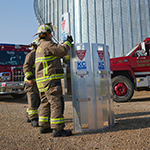Sprinkler system performance
Inspection, testing and maintenance play an important role in fire sprinkler system performance.
Like other building systems, fire sprinkler systems require periodic inspection, testing and maintenance (ITM) to be kept in proper working order. Doing so will help ensure the systems can be relied on to control a fire when the need arises.
Sprinkler system failures and ineffectiveness
According to a study conducted by the National Fire Protection Association (NFPA)*, common causes for sprinkler system failures or ineffectiveness include:
- System was shut off before fire / manual intervention defeats system
- Not enough water released / water does not reach the fire
- Damaged system components
- Lack of system maintenance
Closed valves are the leading cause of sprinkler failures
Closed valves continue to be one of the leading causes of sprinkler system failures. Often, closed valves aren’t reopened after planned sprinkler system testing and maintenance or other related building construction issues, or after unplanned emergency situations that require the sprinkler system water supply to be temporarily shut off, such as a system leakage, a frozen or ruptured pipe or sprinkler, or equipment failure.
If possible, fire sprinkler systems should not be disabled while occupants are in the building. In addition, any required system impairments should only be allowed after authorization from the building owner or other designated representative who ensures necessary precautions have been taken, which may include:
- Determining extent and duration of impairment
- Risk of fire in affected areas identified and reduced
- Fire department notified
- All tools and materials assembled and ready
- Area supervisors notified
- Impairment tags posted at system valves and fire department connection
- Fire watch established for impairments that will last longer than 10 hours
If a system will remain out of service for an extended period of time, be sure to also notify your insurance company of the impairment and when the system is anticipated to be back in service. Once work has been completed, the building owner or designated representative should ensure any closed valves are reopened, the fire sprinkler system is restored to service, impairment tags are removed and authorities are notified.
In addition to these impairment precautions, all fire sprinkler control valves (i.e., shut-off valves) should be secured in the open position (usually with a chain and lock) or located in a locked room accessible only to authorized individuals. And if tamper switches have been installed on control valves to provide supervision and warning through the fire alarm system of a closed valve, those alarm notifications should be investigated.
Inadequate water flow or pressure can be a problem
Inadequate water discharge from a sprinkler system can be the result of a number of issues. For instance, inadequate water flow and/or pressure from the municipal water supply can result from changes in demand of the system over time or from partially-closed upstream valves or obstructions in upstream piping.
One method used to identify a major reduction in available water flow is referred to as the main drain test. Main drains are installed on fire sprinkler system risers to allow water to drain from the system overhead piping whenever certain types of work must be performed. Another function of a main drain is to allow documentation of a baseline flow and residual pressure drop in the supply piping serving the sprinkler system.
NFPA 25 – Standard for the Inspection, Testing, and Maintenance of Water-Based Fire Protection Systems requires a main drain test to be conducted anytime an upstream valve has been closed or operated (valve status test), and annually at each system riser to help determine whether there has been a detrimental change in water supply conditions. Large comparative drops in pressure and/or slow return of the water supply pressure to normal after the main drain is closed, may indicate a problem with the water supply and trigger further investigation for closed valves or obstructions in upstream piping that may be restricting water flow. In addition, the municipality (usually the water department) can be contacted for results of any recent water flow tests from a nearby fire hydrant. These results can be compared to any previous tests for an indication of degraded water supply or pressure from the overall municipal system serving the building.
Often, inadequate spray density is simply the result of what is referred to as shielding of the sprinkler water flow. Shielding can be caused by obstructions to sprinkler spray from such things as building components, large equipment, piping racks, cable trays, rack shelving or storage piles (to name a few). Any time a fire is allowed to grow unimpeded by cooling or wetting from sprinklers, a fire can quickly overwhelm a fire sprinkler system and essentially spread uncontrolled. Therefore, it’s important to identify and correct areas within a building that may be shielded from the spray of fire sprinklers.
Another possible reason for inadequate water discharge from a sprinkler system is excessive internal corrosion of piping, which should be addressed during periodic inspection, testing and maintenance.
Schedule system maintenance and repair damaged system components
NFPA 25 — the standard that provides the requirements for ITM of water-based fire protection systems — indicates the required frequency of testing, which ranges from daily, weekly, monthly, quarterly or annually depending on the type of system and components involved. NFPA 25 is used by most fire protection contractors and authorities having jurisdiction (AHJ) in conducting work and determining compliance.
Some of the more frequent inspection tasks and some of the simpler testing and maintenance items can be performed by facility personnel of the building owner; whereas many other ITM functions are best conducted by qualified fire protection contractors. Building owners should expect to receive detailed reports after ITM work is conducted, indicating the specific action completed, along with recommendations for correction of any deficiencies identified. In any case, prompt correction of any deficiencies is important, particularly those classified by NFPA 25 as an impairment or critical deficiency.
One important inspection NFPA 25 requires to be conducted every 5 years is an assessment of the internal condition of piping for the presence of foreign organic or inorganic material (corrosion, microbiologically induced corrosion or foreign matter). Excessive corrosion in piping can lead to severe restriction or blockage of water flow, blockage at sprinklers and even leaks. Corrosion is typically caused by trapped air (oxygen) in wet pipe systems, pooled water in undrained low spots or moisture in compressed air used to charge dry-pipe systems. As these systems are drained and refilled or when new air is introduced from testing or maintenance activities, additional oxygen allows for continued corrosion.
In some instances, corrosion is increased due to poor water quality. Depending on the extent of findings from the internal assessment of the internal piping or a number of other issues listed in NFPA 25, an obstruction investigation may be required. Removing oxygen through the use of inert nitrogen in fire sprinkler systems (particularly dry-pipe/pre-action systems) is one practical and effective method to reduce the corrosion process. There are many dry-pipe/pre-action systems in the market today.
NFPA 25 requires building owners with dry sprinkler piping passing through walls to serve freezers or cold storage rooms to inspect the piping at these locations for potential ice obstructions every year.
There are a number of methods used for conducting the internal piping assessment/inspection, including opening the piping and visually inspecting and flushing, video bore scopes, radiography/x-ray, or ultrasonic scanning.
Get more information on sprinkler system inspection, testing and maintenance
For more information about fire sprinkler system inspection, testing and maintenance, we encourage you to seek the assistance of your fire protection engineer or contractor, or contact Nationwide’s Property Engineering Group.

 >
>

 >
>
 >
>